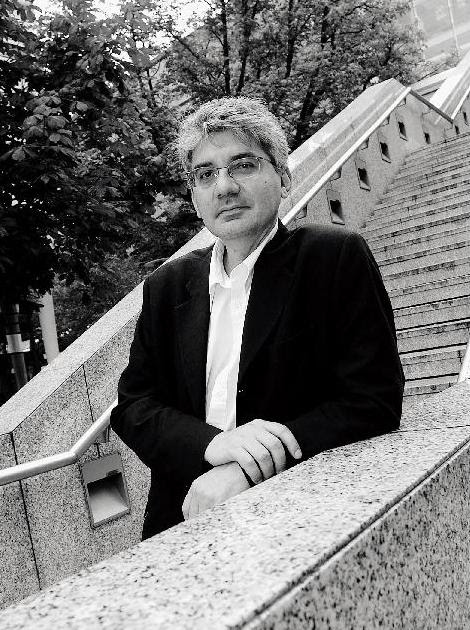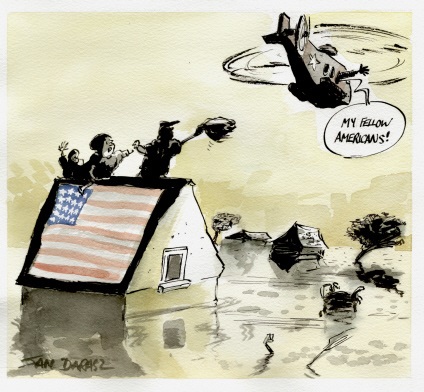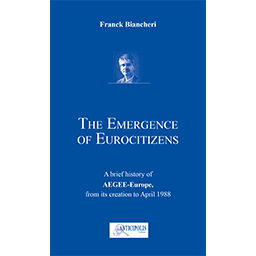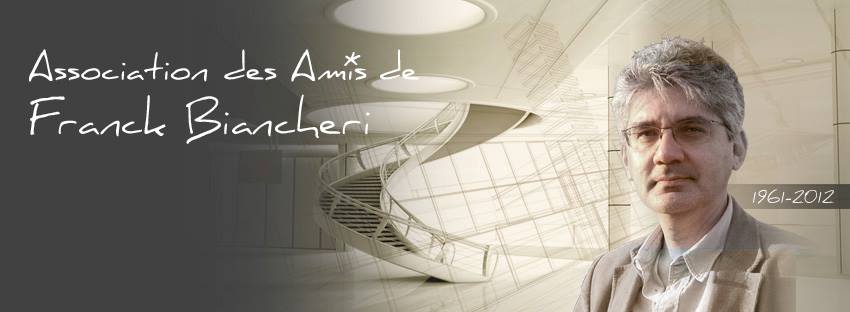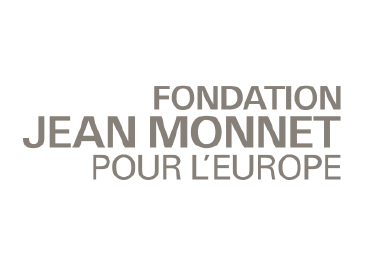The world was totally shocked and horrified by the disastrous show caused by Hurricane Katrina. A different America was exposed there… Beyond the material damage, the human misery emerged from the TV broadcasted images… and the revelation of the weaknesses of the American governance, which took a long time to figure out the magnitude of the disaster and react effectively…
Harvey, the storm devasting Houston and ravaging the region on its way to Louisiana these days, sadly has a taste of déjà vu, and we could take word for word what Franck Biancheri wrote in September 2005 about the storm Katrina. Yet in Houston, as in New Orleans 12 years ago, it was known that this storm was going to happen … We invite you to re-read the conclusions that Franck Biancheri drew from the lesson of Katrina in 2005:
[divider]
News Chronicle: American Tsunami and Foresight
Franck Biancheri, 13/09/2005
[dropcap]T[/dropcap]he world was totally shocked and horrified by the disastrous show caused by Hurricane Katrina. A different America was exposed there, that of the poor black population in Louisiana who had no car to flee. Beyond the material damage, the human misery emerged from the TV broadcasted images… and the revelation of the weaknesses of the American governance, which took a long time to figure out the magnitude of the disaster and react effectively. Everything has been said already on this subject, especially within the American media, and mainly by black journalists. There will definitely be some political consequences to all of that.
Nevertheless, before attending any great political debate, one can ask about connections between foresight and political action, since in this case the scenario was known and was announced with remarkable precision.
In 2004, a risk assessment specialist described quite in detail the “almost unimaginable” dangers faced by the people of New Orleans. No one had listened to her1.
In September 2004, Shirley Laska wrote about Hurricane Ivan as follows:
“New Orleans was spared, this time, but had it not been, Hurricane Ivan would have:
- Pushed a 17-foot storm surge into Lake Pontchartrain;
- Caused the levees between the lake and the city to overtop and fill the city “bowl” with water from lake levee to river levee, in some places as deep as 20 feet;
- Flooded the north shore suburbs of Lake Pontchartrain with waters pushing as much as seven miles inland; and
- Inundated inhabited areas south of the Mississippi River: Up to 80 percent of the structures in these flooded areas would have been severely damaged from wind and water. The potential for such extensive flooding and the resulting damage is the result of a levee system that is unable to keep up with the increasing flood threats from a rapidly eroding coastline and thus unable to protect the ever-subsiding landscape.”
The warning was clear, black on white:
“For those without means, the medically challenged, residents without personal transportation, and the homeless, evacuation requires significant assistance”.
Shirley Laska said further on, about Ivan, in 2004
“Residents who did not have personal transportation were unable to evacuate even if they wanted to. Approximately 120,000 residents (51,000 housing units × 2.4 persons per unit) do not have cars. A proposal made after the evacuation for Hurricane Georges to use public transit buses to assist in their evacuation out of the city was not implemented for Ivan. If Ivan had struck New Orleans directly, it is estimated that 40–60,000 residents of the area would have perished.”
The article was also speaking of people able to flee, but who refused to:
“Researchers have estimated that prior to a “big one,” approximately 700,000 residents of the greater New Orleans area (out of 1.2 million) would evacuate”, wrote Mrs Laska. “In the case of Hurricane Ivan, officials estimate that up to 600,000 evacuated from metropolitan New Orleans between daybreak on Monday, September 13 and noon on Wednesday, September 15, when the storm turned and major roads finally started to clear. The fact that 600,000 residents evacuated means an equal number did not. Recent evacuation surveys show that two-thirds of nonevacuees with the means to evacuate chose not to leave because they felt safe in their homes. Other nonevacuees with means relied on a cultural tradition of not leaving or were discouraged by negative experiences with past evacuations”.
This was not about multiple-future foresight, but a single future forward-looking, based on the extrapolation of the recent past. Hence, beyond the classic complaints of the futurists “If we had been listened to”, we must go to the sources of this improvidence.
The organised reaction was not prepared because infrastructure protection measures were not part of the political agendas2, and the latter were not the translation of a poverty eradication society project. What is at stake is not only the authorities’ incompetence, the cumbersome bureaucracy, the lack of coordination of the echelons of the constitutional structure, but the vision of American society on itself. Apparently, this is not rampant racism, or rampant corruption, explaining the lack of political interest for the inhabitants of the damaged areas, nor the stereotypes of New Orleans3 films and jazz in American public opinion. It is the autism of rich people and their political representatives. Where did those black people come from? We did not know them, and they were disturbing the image of the reassuring liberal America, where everyone had a chance to live the American dream. They were not refugees4, but Americans in misery.
What to conclude from this major event? In my opinion, the great challenge of foresight and politics is to articulate long-term vision, medium-term programme and short-term action. This implies a new praxeology from both foresight and politics. Reactivity can be thought out in advance, 3-5 year long medium-term programmes must be at the confluence of the problems experienced in the present and the guidance of the general orientation of a self-constructed societal programme with the citizens. The debate on the finalities becomes the essential point5. Man and Humanity, and therefore the anthropo, would be the centre and the reason of being; hence the project under development of the “Anthropolitical Prospective”.
A leader’s vision is more and more needed, but it is not a hundred percent safe. Thus Lenin had the vision that the Bolshevik revolution would burn the global proletariat and that a series of revolutions would occur in Europe. There were many attempts in Germany, Austria and Hungary, but they were just straw fires, which led to the construction of socialism in one country, and to improvising strategic retreats with the New Economic Policy (NEP), in particular … and to the tragic drift of the USSR.
Today, any vision must be shared and participative at citizen level. This raises the question of the connection between representative and participative democracy, and it allows Hugues de Jouvenel to answer it like this:
“… a debate occurred between the foresight proponents serving the prince vs. the foresight proponents of the people… a real debate topic. In fact, we need the three of them: a foresight serving decisions, a foresight as a civic political culture, and a foresight serving parliamentary bodies, where, theoretically, a counter-power is exercised vis-à-vis the executive, which is not that of the street but that of democratically elected representatives of the people. “6
Franck Biancheri, 13/09/2005
![]() download pdf file: News Chronicle American Tsunami and Foresight – FB Sept2005
download pdf file: News Chronicle American Tsunami and Foresight – FB Sept2005
[divider]
The article by Franck Biancheri was illustrated with the headed cartoon above by Jan Darasz “Katrina”
[divider]Footnotes:
1 See Courrier International N°775, Sept. 2005 “The catastrophic scenario”, by George Curry in The Black Press of America, Washington.
2 We know, moreover, that money amounts had been transferred to military expenditure in Iraq
3 New Orleans is not America, it’s even its opposite “slow, lazy, sleepy, sweaty, hot, wet and exotic”, but culturally irreplaceable. See Mark Chidress “Why New Orleans will be missed” New York Times- Le Monde September 10, 2005.
4 An adjectif outraging Kentucky black columnist Merlene David, Lexington Herald Leader, reproduced in the CI
5 I am thinking mainly of the current debates on a programme of the Socialist Party in France and more generally on the French left wing where identity is the real issue.
6Hugues de JOUVENEL “Invitation to foresight”, Futuribles, perspectives July 2004. See also his article “The foresight for new citizens”, edited in 1982.
[divider]
More articles by Franck Biancheri:
Le monde a découvert ébahi et horrifié le spectacle de la catastrophe causée par le cyclone Katrina. Une autre Amérique a été mise à nu… Plus encore que le désastre matériel c’est la détresse humaine qui a émergé des images de la télévision. Et la révélation des faiblesses de la gouvernance américaine, lente à réaliser l’ampleur du désastre et encore plus à réagir efficacement…
La tempête Harvey qui dévaste Houston et ravage la région sur sa route vers la Louisiane ces derniers jours, a malheureusement un goût de déjà vu, et nous pourrions reprendre mot pour mot ce que Franck Biancheri écrivait en septembre 2005 à propos de la tempête Katrina. Pourtant à Houston, comme à la Nouvelle-Orléans 12 ans plus tôt, on savait que cette tempête-là allait arriver… Nous vous invitons à relire les conclusions que tirait Franck Biancheri de la leçon de Katrina en 2005:
[divider]
Chronique d’actualité: le tsunami américain et la prospective
Franck Biancheri, 13/09/2005
[dropcap]L[/dropcap]e monde a découvert ébahi et horrifié le spectacle de la catastrophe causée par le cyclone Katrina. Une autre Amérique a été mise à nu. Celle de la pauvreté des noirs de la Louisiane, ceux qui n’avaient pas de voiture pour fuir. Plus encore que le désastre matériel c’est la détresse humaine qui a émergé des images de la télévision. Et la révélation des faiblesses de la gouvernance américaine, lente à réaliser l’ampleur du désastre et encore plus à réagir efficacement. Tout à été dit à ce sujet, particulièrement dans la presse américaine, et plus particulièrement par les journalistes noirs. Il y aura des suites politiques et des règlements de compte.
Mais sans attendre le grand débat, on peut se reposer la question des rapports entre la prospective et l’action politique. Car, en l’occurrence le scénario était connu et avait été annoncé avec une remarquable précision.
En 2004, une spécialiste de l’évaluation des risques avait décrit en détail les dangers “presque inimaginables” que couraient les habitants de La Nouvelle-Orléans Personne ne l’a écoutée1
Shirley Laska écrivait à propos de l’ouragan Ivan de septembre 2004 :
“Cette fois, La Nouvelle-Orléans a été épargnée, mais, si tel n’avait pas été le cas, Ivan aurait :
- provoqué une montée des eaux de plus de 5 mètres dans le lac Pontchartrain ;
- submergé les digues séparant le lac de la ville, entraînant l’inondation de la ‘cuvette’, l’eau s’étendant de la digue du lac à la digue du fleuve et atteignant parfois 6 mètres de haut ;
- noyé les faubourgs de la rive nord jusqu’à plus de 10 kilomètres à l’intérieur des terres ;
- inondé les zones habitées au sud du Mississippi: Dans ces zones, près de 80 % des structures auraient été sérieusement endommagées par le vent et l’eau. Un tel risque, et les dégâts qui en résulteraient, est la conséquence d’un système de digues dépassé par l’aggravation de la menace, elle-même liée à l’érosion rapide du littoral, et donc incapable de protéger un paysage en récession constante.
L’avertissement était clair, exprimé noir sur blanc:
“Les personnes dépourvues de moyens, les personnes sous assistance médicale, les résidents ne disposant pas de moyens de transport personnels et les sans-abri ne pourront être évacués sans aide substantielle.”
Shirley Laska allait plus loin. Lors du passage d’Ivan, en 2004, poursuivait-elle,
“les résidents qui ne disposaient pas de moyens de transport personnels n’étaient pas en mesure de quitter les lieux, même s’ils le souhaitaient. Quelques 120 000 résidents (soit 51 000 logements abritant en moyenne 2,4 personnes chacun) n’ont pas de véhicule. Dans le sillage des évacuations liées au passage du cyclone Georges, il avait été suggéré d’utiliser les bus publics pour faciliter l’évacuation de la ville. Cette mesure n’a pas été appliquée à l’approche d’Ivan. Si ce dernier avait frappé La Nouvelle-Orléans de plein fouet, on estime que 40000 à 60 000 habitants de la région auraient péri.”
L’article s’intéressait également au cas des gens qui, disposant de moyens de partir, s’y refuseraient.
“On estime que, avant un ouragan particulièrement violent, environ 700 000 habitants évacueraient l’agglomération de La Nouvelle-Orléans” écrivait ainsi Mme Laska. “Dans le cas d’Ivan, les responsables calculent que près de 600000 personnes ont été évacuées de la zone métropolitaine du lundi 13 septembre à l’aube au mercredi 15 septembre à midi, moment auquel l’ouragan a obliqué et où les principaux axes routiers ont commencé à se désencombrer. Le fait que 600 000 résidents aient évacué la ville signifie qu’à peu près autant sont restés sur place. Les dernières études à ce sujet montrent que les deux tiers des non-évacués ont refusé de partir parce qu’ils se sentaient à l’abri chez eux. D’autres s’appuyaient sur une tradition culturelle les invitant à rester ou répugnaient à bouger à la suite d’expériences négatives lors de précédentes évacuations.”
Il ne s’agissait pas de prospective, à futurs multiples, mais de prévision à futur unique, basé sur l’extrapolation du passé récent. Dès lors, au-delà des classiques plaintes des futuristes “Ah si on nous avait écoutés !”, il faut aller aux sources de cette imprévoyance.
La réactivité organisée n’était pas préparée parce que les mesures de protection de l’infrastructure ne faisaient pas partie des programmes politiques2, et que ceux-ci n’étaient pas la traduction d’un projet de société éradiquant la pauvreté.
Ce qui est en cause ce n’est pas seulement l’incompétence des autorités, la lourdeur de la bureaucratie, le manque de coordination des échelons de la structure constitutionnelle, mais la vision de la société américaine sur elle même. Il semble que ce n’est pas un racisme rampant, la corruption endémique régnante, qui expliquent le manque d’intérêt politique pour les habitants des régions sinistrées, ni les clichés répandus par les films et le jazz de la Nouvelle-Orléans3 dans l’opinion publique américaine, mais l’autisme des gens aisés et de leurs représentants politiques. D’où sortaient ces noirs qu’on ne connaissait pas, qui dérangeaient l’image rassurante d’une Amérique libérale, où chacun avait ses chances de vivre le rêve américain ? Ce n’étaient pas des réfugiés4 mais des Américains en détresse.
Quelle conclusion tirer de cet événement majeur ? Pour ma part, je pense que le grand défi de la prospective et de la politique est d’articuler vision à long terme, programme à moyen terme et action à court terme. Ce qui implique une nouvelle praxéologie et de la prospective et de la politique. La réactivité peut être pensée à l’avance, les programmes à moyen terme, 3 à 5 ans, doivent être au confluent des problèmes ressentis dans le présent, et de la guidance de l’orientation générale d’un programme sociétal auto-construit avec les citoyens. Le débat sur les finalités devient l’essentiel5, l’Homme et l’Humanité, et donc l’anthropo, le centre et la raison d’être. D’où le projet en cours d’élaboration de la “Prospective Anthropolitique”.
La vision du leader est de plus en plus nécessaire, mais elle n’est pas sans danger. Ainsi Lenine avait la vision que la révolution bolchevik allait embraser le prolétariat mondial et qu’il s’ensuivrait une série de révolutions en Europe. Il y eut bien des tentatives en Allemagne, en Autriche et en Hongrie, mais ce furent des feux de pailles, qui conduisirent à construire le socialisme dans un seul pays, improviser des replis stratégiques avec la Nouvelle Politique Économique (la NEP), notamment…et à la dérive tragique de l’URSS.
Aujourd’hui la vision doit être partagée, citoyenne, participative, ce qui soulève la question des rapports entre démocratie représentative et participative, et permet avec Hugues de Jouvenel d’y répondre :
“… un débat s’est instauré entre les tenants de la prospective au service du prince vs. les tenants de la prospective du peuple. Vrai sujet au demeurant. Nous avons, en fait, besoin des trois : une prospective au service des décisions, d’une prospective comme culture politique citoyenne, et d’une prospective au sein des instances parlementaires, là où, théoriquement, s’exerce vis-à-vis de l’exécutif, un contre-pouvoir qui n’est point celui de la rue mais celui de représentants du peuple démocratiquement élus”6.
Franck Biancheri, 13/09/2005
![]() à télécharger: Chronique d’actualité: le tsunami américain et la prospective (Franck Biancheri, 13/09/2005)
à télécharger: Chronique d’actualité: le tsunami américain et la prospective (Franck Biancheri, 13/09/2005)
[divider]
L’article de Franck Biancheri était illustré par le cartoon en entête de Jan Darasz “Katrina”[divider]
Notes:
1. Voir Courrier International N°775 septembre 2005 “Le scénario de la catastrophe était écrit ” George Curry dans The Black Press of America, Washington.
2. On sait, par ailleurs, que des crédits avaient été transférés au chapitre des dépenses militaires en Irak
3. La Nouvelle-Orleans n’est pas l’Amérique, c’est même son opposite “slow, lazy, sleepy, sweaty, hot, wet, lazy and exotic”, mais culturellement irremplaçable. Voir Mark Chidress “Why New Orleans willbe missed” NewYork Times-Le Monde september 10, 2005.
4. Qualificatif qui indigne la chroniqueuse noire du Kentucky Merlene David, Lexington Herald Leader, reproduit dans CI
5. Je pense, en particulier, aux débats actuels pour un programme du Parti socialiste en France, et plus généralement au sein de la gauche français, où la vraie question est identitaire.
6. Hugues de JOUVENEL “Invitation à la prospective” Futuribles, perspectives juillet 2004. Voir du même auteur l’article “La prospective pour une nouvelle citoyenneté” paru en 1982
[divider]
Lire d’autres articles de Franck Biancheri:
